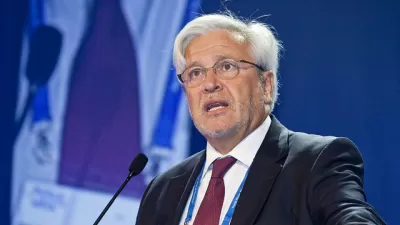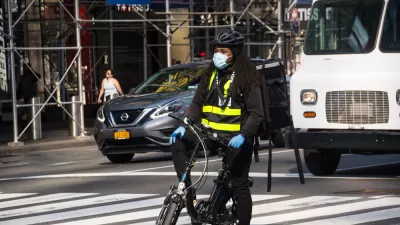The UN Human Settlements Programme (UN-Habitat) has published a flagship report intended to inform preparation of the New Urban Agenda at the Habitat III meetings in Quito in October.

The UN Human Settlements Programme (UN-Habitat) has published a flagship report intended to inform preparation of the New Urban Agenda at the Habitat III meetings in Quito in October. Assessing changes in urbanization since the Habitat II meetings in Istanbul in 1996, and then proposing how urbanization, urban planning, and policy needs to change in the years ahead, World Cities Report 2016: Urbanization and Development: Emerging Futures results from a two year process involving UN staff, consultants, and stakeholders, with financial support from the government of Norway. It is available for download, or for on line review/use.
The report, launched in New York this afternoon, paints parallel pictures of runaway urbanization, environmental degradation, and fast-growing economic and justice challenges, while showing how Habitat II, the Millennium Development Goals, and improvements in best planning, governance, and policy practices have led to important improvements in both urban life on the ground and tools for coping. In the words of UN-Habitat Executive Director Joan Clos:
The Habitat Agenda adopted at the United Nations Conference on Human Settlements (Habitat II) in 1996 was influential in the recognition of the right to adequate housing, sustainable human settlements development in an urbanizing world, and the increased participation of the private sector and non-governmental organizations in the urbanization process. It reinforced the role of local authorities and stirred progress in strengthening fiscal and financial management capacities. However, in general terms, implementation, financing and monitoring have remained major challenges.(UN-Habitat 2016, iv)
The report's ten chapters discuss the 20 year movement from Habitat II to Habitat III, urbanization as a transformative force, housing, the widening urban divide, justice and sustainability, urban governance, reinventing city planning, changing urban economies, and principles and proposed components of the New Urban Agenda. It's key messages are summarized:
When well-managed, urbanization fosters social and economic advancement and improved quality of life for all.
The current model of urbanization is unsustainable in many respects. Many cities all over the world are grossly unprepared for the challenges associated with urbanization.
A new agenda is required to effectively address these challenges and take advantage of the opportunities offered by urbanization.
The new urban agenda should promote cities and human settlements that are environmentally sustainable, resilient, socially inclusive,safe and violence-free, economically productive (http://unhabitat.org/un-habitat-launches-the-world-cities-report-2016/)
Chapter Seven, "A city that plans: reinventing urban planning," for which I served as lead consultant, examines changes in city planning across the globe in light of the principles of New Urban Planning discussed in 2006 at the World Urban Forum in Vancouver. Main findings include:
1 Today, many cities in the world still rely on outdated modes of planning notwithstanding that planning is central to achieving sustainable urban development.
2 Cities across the world are sprawling, and as such, densities are dramatically declining. In developing countries, a one per cent decline in densities per year between 2000 and 2050 would quadruple the urban land area.
3 Planning frameworks in most cities are not gendersensitive; consequently, women are often left outside of the planning process and decisions.
4 Planning capacity is grossly inadequate in much of the developing world. In the UK, there are 38 planners per 100,000 population, while in Nigeria and India the figure is 1.44 and 0.23 respectively.
5 Integrated, multi-sectoral planning approaches have a strong success record and should be used in many more cities and regions.
6 Local circumstances, needs and requirements must remain pre-eminent in urban planning, so are gender considerations and involvement of—and responsiveness to—the diverse populations.
7 Plans should be prepared at various geographic scales and integrated to support sustainable and coordinated road, transit, housing, economic development and land use across geographic and political boundaries.
8 In developing countries, education and training for professional planners should be increased and capacity for planning education be enhanced, concomitantly.
The Habitat III process has seemed remote to many U.S. planners, but it's impact will be vital to all of us. Population growth, resource depletion, pollution, and the immigration and security impacts of social exclusion and unrest touch every city in every nation.
Even from our own narrow domestic perspective, many of the best ideas for solving urban problems are being developed abroad. To succeed in coping with the pressures of urban growth, we must pay attention to innovations in other countries. Investments in infrastructure are not optional; world class roads, transit, schools, and utilities are key to economic competitiveness as well as quality of life. Many of our competitors get this; we have to as well. Our urban growth and environmental challenges frequently have global dimensions: to respond to sea level rise, pollution, security in an age of terrorism, and to increase jobs and trade, we have to work together with others around the world.
See the full World Cities Report 2016: Urbanization and Development: Emerging Futures.

Alabama: Trump Terminates Settlements for Black Communities Harmed By Raw Sewage
Trump deemed the landmark civil rights agreement “illegal DEI and environmental justice policy.”

Study: Maui’s Plan to Convert Vacation Rentals to Long-Term Housing Could Cause Nearly $1 Billion Economic Loss
The plan would reduce visitor accommodation by 25% resulting in 1,900 jobs lost.

Why Should We Subsidize Public Transportation?
Many public transit agencies face financial stress due to rising costs, declining fare revenue, and declining subsidies. Transit advocates must provide a strong business case for increasing public transit funding.

Wind Energy on the Rise Despite Federal Policy Reversal
The Trump administration is revoking federal support for renewable energy, but demand for new projects continues unabated.

Passengers Flock to Caltrain After Electrification
The new electric trains are running faster and more reliably, leading to strong ridership growth on the Bay Area rail system.

Texas Churches Rally Behind ‘Yes in God’s Back Yard’ Legislation
Religious leaders want the state to reduce zoning regulations to streamline leasing church-owned land to housing developers.
Urban Design for Planners 1: Software Tools
This six-course series explores essential urban design concepts using open source software and equips planners with the tools they need to participate fully in the urban design process.
Planning for Universal Design
Learn the tools for implementing Universal Design in planning regulations.
Caltrans
Smith Gee Studio
Institute for Housing and Urban Development Studies (IHS)
City of Grandview
Harvard GSD Executive Education
Toledo-Lucas County Plan Commissions
Salt Lake City
NYU Wagner Graduate School of Public Service






























